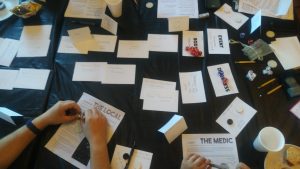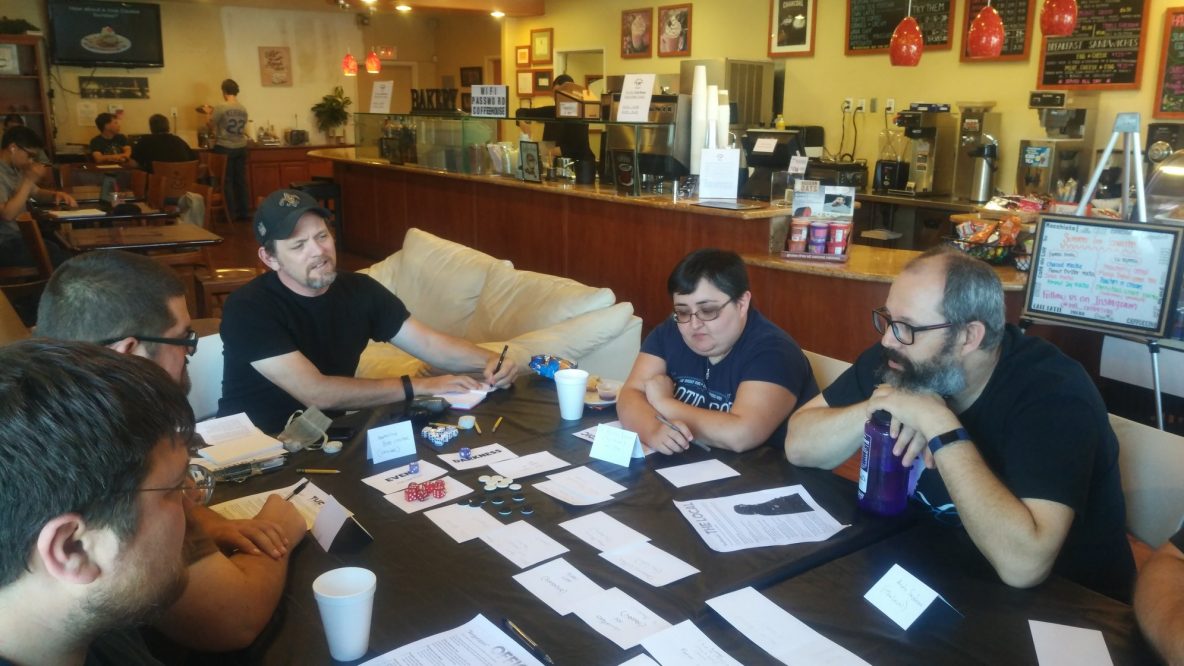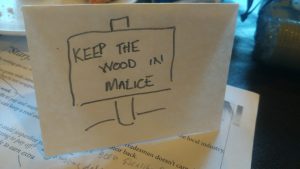 This update is primarily about the recent playtests run at the mini-con sponsored by the Dead Gamers Society gaming group in Orange County. These folks are good people – they have a consistent player group that normally focus on White Wolf-based products such as Vampire: The Masquerade, but have been a friend to Monkeyfun since we first started running playtests for Spirit of 77. It’s been a bit of a tradition for me to bring out my newest projects for them to playtest, either at their mini-con or have them sitting at a player’s table during Strategicon. So I was really excited to have them play Malice for the first time.
This update is primarily about the recent playtests run at the mini-con sponsored by the Dead Gamers Society gaming group in Orange County. These folks are good people – they have a consistent player group that normally focus on White Wolf-based products such as Vampire: The Masquerade, but have been a friend to Monkeyfun since we first started running playtests for Spirit of 77. It’s been a bit of a tradition for me to bring out my newest projects for them to playtest, either at their mini-con or have them sitting at a player’s table during Strategicon. So I was really excited to have them play Malice for the first time.
Before I go any further, I may get a little game mechanic crunchy so I apologize in advance, I’ll talk about the lighter stuff towards the end. Just look for the funny sign about wood.
Now full disclosure for a moment – I’m locally infamous for running game sessions with full tables (easily seven people at a time, and if you’re doing more than that, you’re only hurting yourself). So I was curious to see if anyone would sign up for this new system, and sure enough, I had a sign-up of six, and myself. I had taken Malice to the Glendale Story Game Meetup a few weeks back, and also had seven players involved the session which caused me to reconsider how that would work. Let me explain –
- For a normal game, there’s two Acts (excluding the Final Confrontation scene). Each Act focuses on each player for two game scenes as the Spotlight Player (basically they’re driving the action towards the game’s Story Pillars).
- Each Scene lasts about five to seven minutes ideally, but will usually go a little longer. That’s a minimum of ten minutes per person, even in the quickest of scenarios. For seven players, that’s 70 minutes. For two Acts, that’s easily 140 minutes (or more. Probably more). That doesn’t even include the Setup, which will usually take thirty to forty-five minutes and then the Final Confrontation, that can be around twenty to thirty minutes.
That’s a little lengthy, especially when players can be excluded from scenes depending on the actions taking place. For hardcore players, that’s not a problem but for someone new to the system or larger games, there’s some dead time that I would prefer not to have. I’m a wimp, I like games to be done in three hours if possible. (I like to go to bed early).
You know, maybe if I ran smaller games, I might be able to pull off longer games. This literally just occurred to me.
Anyway, the large group compromise is splitting the two acts into three, with one scene per Act per player as Spotlight Player. This also includes some finagling of the mechanics on how the Pillars grow in intensity and power as the game progresses, but it’s not too bad. This was the first time I tested this out, and it worked pretty well. Although the Dead Gamers, being a crafty bunch, found another little edge case that requires some thought.
Going back to the workings of a Scene, the Spotlight Player resolves their Scene by rolling dice against an Opposition Pool. For every player involved in that scene, they can add a die. So if you and I are in the scene together, that’s two dice against the Opposition Pool. Sound good so far? There is also a mechanic that you can add a die to your dice pool if you are working toward your character’s personal goal. Again, not so bad. But if you have seven players, and everyone is involved in the Scene, and everyone has added a die to their dice pool, we’re talking 14 dice in the player’s pool. It gets worse when players max their dice pool to 3. With a smaller group, not so bad. With a larger group… it’s pretty monstrous. So… the other conceit is to limit the max of a players’ personal dice pool (excluding others) to 2, as opposed to 3.
Okay… if you wanted to skip the mechanics crunching, you can come back now.
So the game went well, and I’m very thankful the players provided some interesting feedback and scenarios that I had not anticipated. And here’s the point of where I’m going with this – I really like taking my prototype games to conventions, because I never know who I’m going to see at the table. They may be hardcore players, they may be trying out something outside of D&D 5e for the first time (which happened to me at the last convention). You just don’t know what will happen, so I have been doing what I can to try out Malice with as many varied player groups as possible. And that’s required me driving out to places I wouldn’t normally bring games (e.g. Glendale, Orange County, etc) to see what happens with people out of my immediate sphere of influence. I plan to travel up to the Pacific Northwest in a few weeks and will be showing the game to those folks, as well as the creator of the Story Pillar System itself, Jason Olsan of Protagonist Industries. Should be neat.


